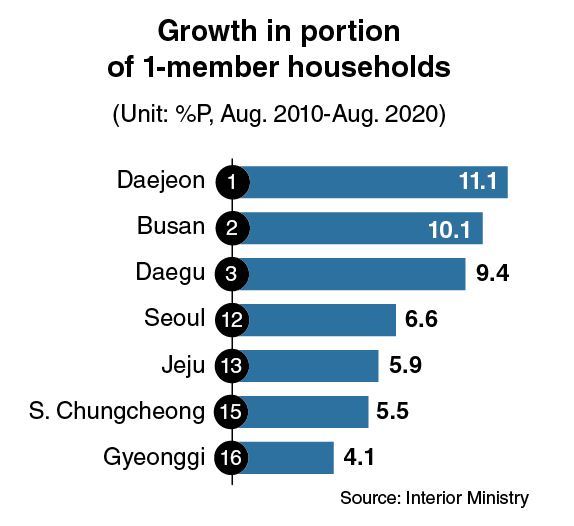[News Focus] Daejeon fastest in growth of single-person households
Of 16 areas nationwide, Busan, Daegu, Gwangju rank within top 4
By Kim Yon-sePublished : Sept. 24, 2020 - 14:59
SEJONG -- Daejeon and Busan recorded the highest and second-highest growth in the proportion of single-person households relative to all households over the past decade, among the 16 major cities and provinces in South Korea.

According to the Ministry of Interior and Safety, single-person households came to 38.7 percent of the nationwide total as of August. The figure grew 6.6 percentage points in a decade, having posted 32.1 percent in August 2010.
Daejeon topped the list in terms of growth, with the percentage of one-member households in the city having increased by 11.1 percentage points over the corresponding period, from 27.8 percent to 38.9 percent.
The number of single-person households in the city surged more than 100,000, from 151,195 to 252,510. The total number of households in Daejeon was 647,818 as of August 2020.
Busan ranked second with 10.1 percentage point growth from 28 percent to 38.1 percent, followed immediately by Daegu with 9.4 percentage points and Gwangju with 8.7 percentage points.
Daejeon, Busan, Daegu and Gwangju are the nation’s fifth-largest, second-largest, fourth-largest and sixth-largest cities in turn.
Next on the list in the growth of single-person households were North Jeolla Province at No. 5 with 8.4 percentage points, North Chungcheong Province at No. 6 with 8.1 percentage points, South Jeolla Province at No. 7 with 7.7 percentage points and North Gyeongsang Province at No. 8 with 7.5 percentage points.

Seoul ranked 12th with 6.6 percentage point growth, about the same as the nationwide average, with the proportion of single-person households in the city having increased from 35 percent to 41.6 percent.
In contrast, the figure posted the slowest growth in Gyeonggi Province, the nation’s most populous area -- just 4.1 percentage points, from 31.1 percent to 35.2 percent.
Jeju Province, Incheon and South Chungcheong Province also posted lower-than-average figures of 5.9, 5.7 and 5.5 percentage points, respectively.
Nonetheless, the government data indicates that the number of people residing alone has rapidly increased across the 16 major areas studied. Sejong, which was launched in July 2012 and now constitutes one of the nation’s 17 major areas, was not included in this 10-year comparison.
In terms of the proportion of single-person households relative to the total in 2020, South Jeolla Province stood at No. 1 with 44.3 percent. Gangwon Province was next with 42.9 percent, followed by North Gyeongsang Province with 42 percent.
Seoul and South Chungcheong Province tied at No. 4 with 41.6 percent, followed by North Chungcheong Province with 41.5 percent, and Jeju and North Jeolla provinces with 41.3 percent each.
A government official attributed Seoul’s high ranking to the number of young, unmarried people in their 20s and 30s working or studying in the capital amid low marriage and fertility rates.
“As for figures held by provinces, a growing number of older people are residing alone in rural areas after losing a spouse and with their married children having moved to metropolitan cities,” he said.
For 2020, Sejong and Ulsan posted the lowest (32.6 percent) and second-lowest (33 percent) figures. Gyeonggi Province stood at No. 15 with 35.2 percent.
Nationwide as of last month, the tally of single-person households was 8.87 million out of 22.89 million households. The number of two-member and three-member households posted 5.31 million and 4.01 million, respectively.
The figures for four-member and five-member households were 3.56 million and 890,000.
By Kim Yon-se (kys@heraldcorp.com)












![[Today’s K-pop] BTS pop-up event to come to Seoul](http://res.heraldm.com/phpwas/restmb_idxmake.php?idx=644&simg=/content/image/2024/04/17/20240417050734_0.jpg&u=)




![[KH Explains] Hyundai's full hybrid edge to pay off amid slow transition to pure EVs](http://res.heraldm.com/phpwas/restmb_idxmake.php?idx=652&simg=/content/image/2024/04/18/20240418050645_0.jpg&u=20240418181020)

![[Today’s K-pop] Zico drops snippet of collaboration with Jennie](http://res.heraldm.com/phpwas/restmb_idxmake.php?idx=642&simg=/content/image/2024/04/18/20240418050702_0.jpg&u=)